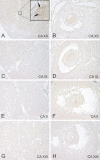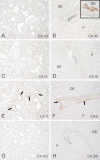Transmembrane carbonic anhydrase isozymes IX and XII in the female mouse reproductive organs
- PMID: 15488153
- PMCID: PMC526762
- DOI: 10.1186/1477-7827-2-73
Transmembrane carbonic anhydrase isozymes IX and XII in the female mouse reproductive organs
Abstract
Background: Carbonic anhydrase (CA) classically catalyses the reversible hydration of dissolved CO2 to form bicarbonate ions and protons. The twelve active CA isozymes are thought to regulate a variety of cellular functions including several processes in the reproductive systems.
Methods: The present study was designed to investigate the expression of transmembrane CAs, CA IX and XII, in the mouse uterus, ovary and placenta. The expression of CA IX and XII was examined by immunoperoxidase staining method and western blotting. CA II and XIII served as positive controls since they are known to be present in the mouse reproductive tract.
Results: The data of our study indicated that CA XII is expressed in the mouse endometrium. Only very faint signal was observed in the corpus luteum of the ovary and the placenta remained mainly negative. CA IX showed weak reaction in the endometrial epithelium, while it was completely absent in the ovary and placenta.
Conclusion: The conservation of CA XII expression in both mouse and human endometrium suggests a role for this isozyme in reproductive physiology.
Figures





Similar articles
-
Expression of carbonic anhydrases IX and XII during mouse embryonic development.BMC Dev Biol. 2006 May 23;6:22. doi: 10.1186/1471-213X-6-22. BMC Dev Biol. 2006. PMID: 16719910 Free PMC article.
-
Estrogen and progesterone differentially regulate carbonic anhydrase II, III, IX, XII, and XIII in ovariectomized rat uteri.Syst Biol Reprod Med. 2016;62(1):57-68. doi: 10.3109/19396368.2015.1112699. Epub 2015 Dec 28. Syst Biol Reprod Med. 2016. PMID: 26709452
-
Carbonic anhydrase inhibitors. Inhibition of cytosolic/tumor-associated carbonic anhydrase isozymes I, II, IX, and XII with Schiff's bases incorporating chromone and aromatic sulfonamide moieties, and their zinc complexes.Bioorg Med Chem Lett. 2005 Jun 15;15(12):3096-101. doi: 10.1016/j.bmcl.2005.04.055. Bioorg Med Chem Lett. 2005. PMID: 15908204
-
The cellular physiology of carbonic anhydrases.JOP. 2001 Jul;2(4 Suppl):159-64. JOP. 2001. PMID: 11875253 Review.
-
Designing of novel carbonic anhydrase inhibitors and activators.Curr Med Chem Cardiovasc Hematol Agents. 2004 Jan;2(1):49-68. Curr Med Chem Cardiovasc Hematol Agents. 2004. PMID: 15328829 Review.
Cited by
-
Hydroxysafflor yellow A attenuates oxidative stress injury-induced apoptosis in the nucleus pulposus cell line and regulates extracellular matrix balance via CA XII.Exp Ther Med. 2022 Feb;23(2):182. doi: 10.3892/etm.2021.11105. Epub 2021 Dec 30. Exp Ther Med. 2022. PMID: 35069863 Free PMC article.
-
Autosomal recessive hyponatremia due to isolated salt wasting in sweat associated with a mutation in the active site of Carbonic Anhydrase 12.Hum Genet. 2011 Apr;129(4):397-405. doi: 10.1007/s00439-010-0930-4. Epub 2010 Dec 24. Hum Genet. 2011. PMID: 21184099
-
Conditional gene expression in the mouse using a Sleeping Beauty gene-trap transposon.BMC Biotechnol. 2006 Jun 26;6:30. doi: 10.1186/1472-6750-6-30. BMC Biotechnol. 2006. PMID: 16800892 Free PMC article.
-
Genistein disrupts glucocorticoid receptor signaling in human uterine endometrial Ishikawa cells.Environ Health Perspect. 2015 Jan;123(1):80-7. doi: 10.1289/ehp.1408437. Epub 2014 Aug 19. Environ Health Perspect. 2015. PMID: 25136773 Free PMC article.
-
Immunohistochemical assessment of intrinsic and extrinsic markers of hypoxia in reproductive tissue: differential expression of HIF1α and HIF2α in rat oviduct and endometrium.J Mol Histol. 2011 Aug;42(4):341-54. doi: 10.1007/s10735-011-9338-2. Epub 2011 Jul 6. J Mol Histol. 2011. PMID: 21732047 Free PMC article.
References
-
- Parkkila S, Parkkila AK. Carbonic anhydrase in the alimentary tract. Roles of the different isozymes and salivary factors in the maintenance of optimal conditions in the gastrointestinal canal. Scand J Gastroenterol. 1996;31:305–317. - PubMed
Publication types
MeSH terms
Substances
Grants and funding
LinkOut - more resources
Full Text Sources

